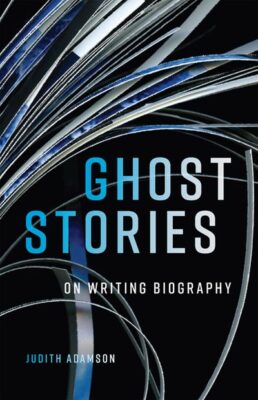Judith Adamson’s Ghost Stories is an exploration of biography as a form of storytelling. A memoir itself, the book describes Adamson’s own path into literature and academia, situating her in the vibrant literary scenes of Montreal and London during the second half of the twentieth century. Through accounts of her relationships with her biographical subjects – largely writers and artists like Graham Greene, Charlotte Haldane, and Trekkie Ritchie Parsons – she shows us that the biographer is not merely a stenographer. As is the case with any writer, they transform a story – a collection of events, observations, experiences – into a narrative. Ghost Stories shows how this transformation is mediated by archives, institutions, and the biographer’s own social position.

Ghost Stories
On Writing Biography
Judith Adamson
McGill-Queen’s University Press
$24.95
paper
200pp
9780228021032
Challenges are also posed by the specific locations of archives and how their use is governed by the institutions that own them. For instance, while researching Charlotte Haldane, Adamson is presented with “boxes of disordered papers and not allowed to copy anything, or [confronted] with old and overused machines to reproduce even older microfilm or newsprint.” However, she values the process of navigating the physical archive, especially when she compares it to the relative ease created by digitization: “But if electronic searches are easier, they also dampen the hunt and, frustrating as the trail often was, I loved following the breadcrumbs Charlotte had left.”
There is some sense in which this sentiment overlooks how historical records are fortified from the public and undermines the value of greater access to them. However, it also gestures to the way in which physical archives – due to the absence of distraction, the necessity to recall information in the future – allow a writer to experience a deeper form of attention.
Adamson also examines how events are curated in a biography. How does the biographer choose not only what to include, but where to include them in the chronology of someone’s life? Particularly when portraying women writers, Adamson considers the political implications of the events she chooses to centre, as well as where she chooses to begin or end the story. At the same time, she values what she calls “critical distance” in her writing, the ability to immerse oneself in the subject’s motivations and desires without projecting onto them one’s own personal baggage or historically specific paradigms.
This is perhaps a delicate balance because, as Adamson goes on to suggest, her narratives were impacted by what she “was doing while [she] was writing – mothering, teaching, and being a wife.” Ghost Stories indicates that such roles not only give the biographer a particular point of view, but also structure their time in decisive ways.
Biography may centre the individual, but often these individuals’ lives stand in for the experiences of communities or offer insight into historical situations. Moreover, the genre makes what is intimate available for public interpretation. Adamson expresses her sensitivity for the privacy of her subjects: “To whom did our lives in fact belong?” she asks. “As a biographer, the question challenged me for decades. I’d found so much about people’s secret lives that I knew was enticingly publishable. But early on I had decided to hold back anything that didn’t add to our understanding of literary or cultural history.” It is not always clear what ought to be disclosed or protected, but Adamson points to how a sense of ethical responsibility guides the biographical process. Ultimately, the biographer must reconcile her private attachment to her subjects with her commitment to produce a narrative that matters to the public.mRb






0 Comments